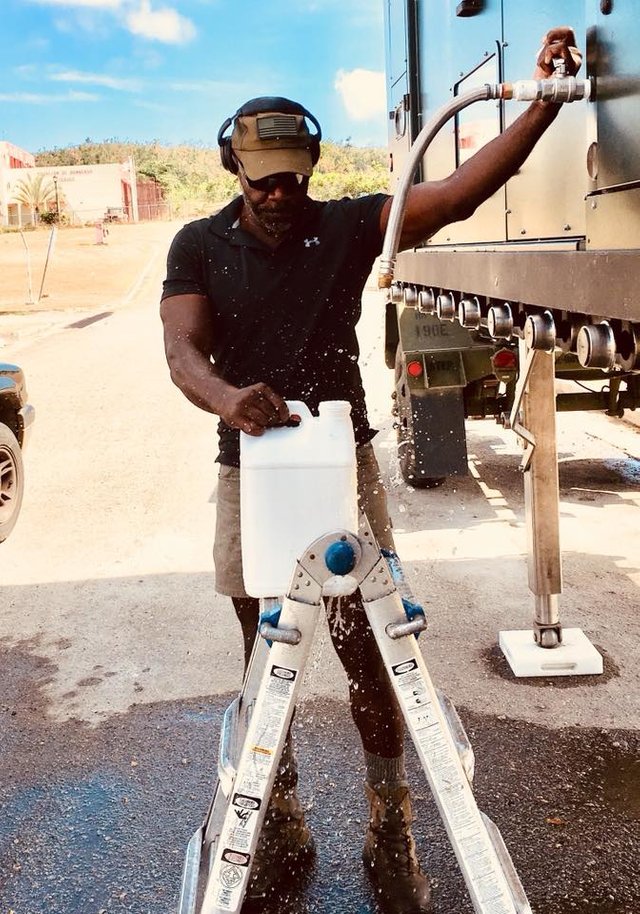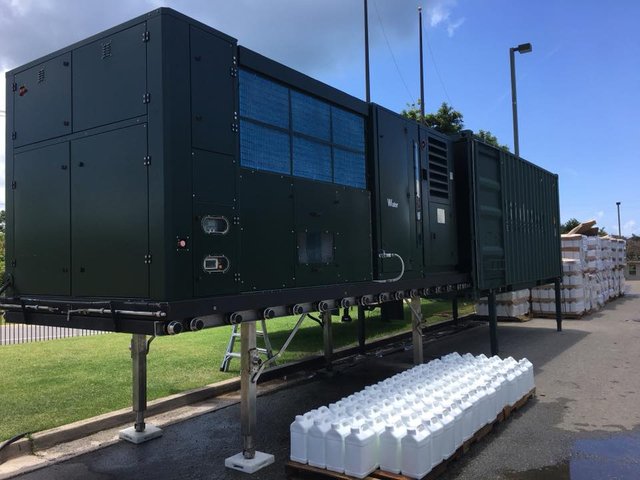Made In America: Moses West's Atmospheric Water Generator
“The hydrological cycle”
The first time I met with former US Special Operator turned inventor/entrepreneur Moses West, he referend the hydrological cycle dozens of times. It of a mantra for Moses West, then inventor of an optimized HVAC compressor that hacks the natural water cycle to create potable water, on demand, in large quantities. Since leaving the Special Forces, Moses has concentrated on optimizing his invention for use by US Army during deployments to areas like the Middle East, where bases are often remote outposts and reliable sources of potable water are few and far between. In the wake of Hurricane Maria, that devastated the U.S. territory of Puerto Rico, Moses West once again deployed into the field, this time not as a warrior but as a humanitarian.
I had been on the ground in Puerto Rico since the 5th of October as a member of a SAR/CERT unit when I began receiving calls in December from a gentleman I had met by chance at a Marco Island airfield after Irma had wreaked havoc in South Florida. He was checking to see if I had shipping connections, which at that time I did not but was willing to reach out to all the connections I had made volunteering during Harvey, Irma and Maria to see what could be done. He had been put in touch with Texan who had a machine that could manufacture water out of thin air.
The importance of a portable industrial potable water machine was not lost on me, but the connects weren’t to be found in my sphere. None-the-less I kept up with the journey of Mr. West and his machine by watching the social media posts for Mr. West’s organization, “The Water Rescue Foundation.” All this was happening about the time that the truth about the situation in Vieques was making national headlines. I happened to catch onto the severity of the situation a day too early and posting about it on social media got me kicked out of my SAR/CERT group. For those who don’t know, Vieques, a sub island to the Southeast of Puerto Rico’s main island had taken a direct hit from Maria before the storm moved on to the main island and rewrote the topographical map with her ferocity. 3 months after the storm had passed, the restoration of power to the small island was still a distant prospect. The underwater cable feeding power from the main island to Vieques was severed during the storm.
So why was it necessary for Mr. West’s invention to go to Vieques and not the main island of Puerto Rico?
The primary reason is the isolation of Vieques in terms of utility infrastructure and the now famous instability of the ferries that service the island.
Cutting the main power line to the island from Puerto Rico’s main island means that the “sub island” was cut off from the main generation capabilities of AEE (Autoridad de Energía Eléctrica). The massive emergency generators on Vieques failed, unlike those from Culebra, another sub island of Puerto Rico located to the North of Vieques. Add in that two of the four ferries that service Vieques and Culebra are currently inoperable and the two that are operating are aging and often breaking down and fuel for backup generators becomes difficult to come by.
Why is the power situation significant to the issue of potable water? Water stations rely on pumps, which require electricity. The more unstable the electrical grid, the more the back up generators at pump stations end up being overused and subsequently breaking down. When the pump system is compromised, well water is used for drinking in Vieques. The problem with using well water, is that Maria’s storm surge inundated parts of the island with saltwater. This inundation can push nitrite concentrations to unsafe levels.
What Makes Moses West’s AWG (Atmospheric Water Generator) Special?
The true genius of Mr. West’s AWG is in the efficiency of the system’s operation. The entire is packaged shipping container that can literally be set anywhere that a semi can haul the container. The container is offload and stands on metal poles pillars fold against the bottom of the container. A metal extension is pulled out that also has foldable metal poles and the machine is rolled from the container onto the extension for operations. The entire unit, when deployed is 43 feet in length.
Essentially the system is a modified HVAC air compressor that when powered draws in and condenses moisture from the surrounding air. Essentially, Mr. West’s machine creates a small rainstorm inside the machine itself. The water then moves from the collection area, through a specialized filter, into a reservoir located onboard. From the reservoir the water can be released by gravity through a hose that pipes into the reservoir and when the machine is on the hose will pressurize the waterflow. At the time of my visit the AWG was powered by an onboard diesel generator. The AWG’s daily yield is over 7,000 liters per day. In Vieques that means the machine can product one liter of potable water, every day for every single resident of the island. Pretty impressive for a machine that is taking up about as much parking space as a family RV.
Currently, the AWG in Vieques is stationed just outside of Veterans Administration Diagnostic Center than was damaged by hurricane Maria, adjacent to a National Guard Mash unit established that currently served as the emergency medical center for Vieques. Recently a few organizations stepped up to deliver Moses with an industrial extension cord, additional solar panels and a Tesla Battery back that means the net energy input required to power the AWG is being met every single day by completely renewable resources. The only components of the machine that require scheduled maintenance are the filters attached to the AWG’s air intake that can be cleaned by simply rinsing them with water from the machine’s reservoir and periodic refills to the coolant reservoirs that play a vital role in the condensation process. The Moses West’s AWG in it’s current state is one of the finest examples of “net zero” engineering to be found. Moses West's idea was to integrate the solar installation and AWG's water generation in a way that would allow the entire facility to operate on a "net zero" schedule.
“The humidity here is ideal”
The humidity of the tropical climate in Puerto Rico can be downright brutal for at times for anyone who may work outdoors but it is perfect for keeping the Moses West AWG working at maximum efficiency. The higher the concentration of atmospheric moisture, the less energy machine must consume to create condensate. The high UV Index of the Caribbean is also a boon for the solar microgrid powering the machine, so much so that the team had to tweak the system’s connections to the attached battery pack.
When I pressed Moses on specs like the composition of the filter, he responded, “I can’t give away all my secrets.” After all Moses does own the patent on his AWG which he manufactures at a production facility in Austin, Texas. A machine that is also FDA licensed and approved. However, talking at length with Moses and looking into his 501c3 charitable organization The Water Rescue Foundation, it is clear Moses enjoys sharing his invention with the world even if it means missing opportunities to profit or even continuing to hold the patent.
In the mind of Moses West the utility of his AWG is more important than the profits. When we discussed the vast utility of his invention Mr. West said that if interest if he couldn’t find avenues to make his invention more accessible during his lifetime then he would “open source the patents and let someone else figure it out.”
As for if he thinks he is losing out by producing the machine primarily through his 501c3 as opposed to the U.S. military contracts that initially subsidized his invention, Moses had this to say;
“I’d rather have it out here right now (In Vieques) than tucked away in a hangar on base.”
The residents of Vieques are happy to have the AWG on their island as well. It’s an extra blanket of security if the pumps stop and in reality, is probably survival essential for some residents of Vieques given that the entire island relies on a tourist economy t hat is still trying to recover in the wake of Maria and was already suffering from the unstable ferry schedule which has made the delivery of every product sold on the shelves in Vieques an even more difficult task.
What’s Next for Moses and the AWG?
According to some comments from Moses’s foundation on social media, the next AWGs he manufactures could be bound for Flint, Michigan, where lead concentrations in the municipal water have forced officials to declare a state of emergency. Wherever Moses goes next one thing is for sure… He is an American hero making an American product for the well being of every American and this nation should be proud to have him.
For more information on how you can help Moses West Manufacture his AWGs for humanitarian missions visit his website here or check out his Facebook here
Special thanks to Moses West, Margarita Mendoza of Made in America, Christian Michael Oakes of FlipFlopFlotilla, Jana Stone of Black Flag Search and Rescue, Rebecca Poventud, and Aurimas for contributing to this article.



✅ @domestictiger, I gave you an upvote on your first post! Please give me a follow and I will give you a follow in return!
Please also take a moment to read this post regarding bad behavior on Steemit.